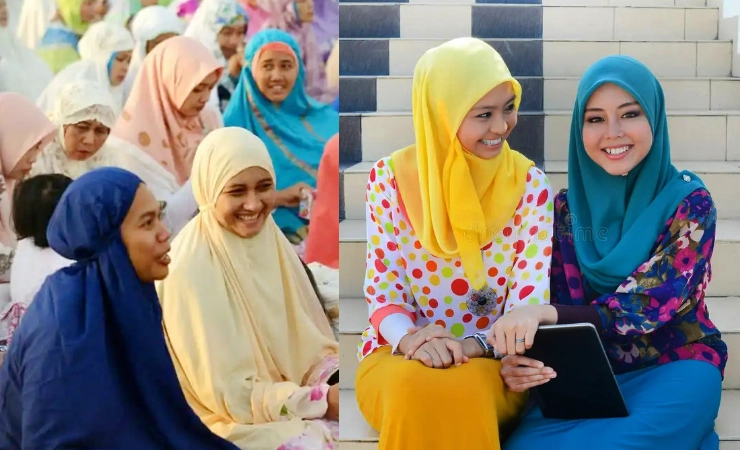
Clothing in South Africa varies significantly among different tribes and cultural groups. Each tribe or ethnic group has its own traditional attire, which reflects its unique customs, beliefs, and history. These clothing styles often incorporate distinctive patterns, colors, fabrics, and designs that are specific to the particular cultural group.
Cape Malay
Cape Malay is a minority ethnic group, migrated to South Africa from Southeast Asia during the era of the slave trade. In Cape Town, where they are predominantly settled, the Cape Malay community adheres largely to the Muslim faith. While their everyday attire typically mirrors Western clothing, they don traditional garments for mosque visits, attending madrassah, and during special celebrations, much like Indian South Africans.
Cape Malay women adhere to religious practices by wearing variations of the Muslim headscarf, often paired with long skirts or attire reminiscent of the Middle East during gatherings within the Muslim community.
Men typically wear skull caps or turbans and robes inspired by Arabian fashion when attending mosque services. Among the elders, the fashion trend used to include red fezzes paired with suits and ties for specific occasions, but these have been supplanted by high white Kufiyas. Over time, the fashion landscape has shifted towards Western casual wear, blurring the lines between Cape Malay attire and that of non-Muslims, making their distinction more challenging.
Xhosa
Clothing of the Xhosa people are intricate, shaped by rites of passage and social status.
For women, attire and accessories symbolize various life stages. Traditional Xhosa dress typically includes long skirts and aprons crafted from stunning printed or embroidered fabrics. Adornments like intricate beaded necklaces, known as “ithumbu,” grace their necks, along with beaded bracelets and anklets. Married women traditionally don the “iqhiya,” a headscarf, while embroidered capes or blankets complete their look.
Xhosa men traditionally fulfill roles as warriors and hunters, often incorporating animal skins into their attire. On special occasions, they may wear embroidered skirts paired with a rectangular cloth draped over the left shoulder or opt for a tunic complemented by strands of beaded necklaces.
Zulu
Similar to Xhosa culture, Zulu women also undergo wardrobe changes corresponding to different life stages. Unmarried young women typically sport short hairstyles and wear grass reed skirts adorned with beads. As they become engaged, these outfits remain similar but include covering the bosom and allowing the hair to grow out.
Upon marriage, a woman’s attire transforms to signify her marital status. She covers her entire body, often with a thick cowhide skirt softened with animal fat and charcoal. While traditional customs included covering the bosom with cloth, modern variations may feature cotton vests or beaded bras, accompanied by beaded necklaces. A distinctive element of married women’s attire is the circular grass and cotton hats, known as “izicolo”.
Zulu men traditionally dress in animal skins and feathers, with the type of skins indicating their status. Cow tail tufts, called “amashoba,” are worn on the upper arms and below the knees to create the illusion of broader stature.
The traditional apron worn by men to cover their buttocks is known as “ibheshu,” crafted from calf-skin for its softness and ease of processing. There are two lengths available: knee-length for younger men, ideal for activities like fighting, hunting, and dancing, and ankle-length for older men, who are less active in such pursuits.
Tsonga
Originating from the Zulu tribe, the Tsonga (Shangaan) tribe primarily inhabits the northern provinces of South Africa. In their traditional attire, Tsonga men wear animal skins, whereas women opt for vibrant beads and gathered skirts known as “xibelani”.
Ndembele
Ndebele tribe is renowned for their vibrant and intricate beadwork. A prominent aspect of Ndebele women’s attire is the apron. Young girls adorn small beaded aprons, while older girls receive “isiphephetu” from their mothers, which are elaborate beaded aprons. They also wear “isigolwani,” thick beaded hoops around their necks, arms, legs, and waist.
Married Ndebele women wear longer aprons crafted from hardened skin, intricately adorned with geometric designs. Additionally, they wear “isigolwani” and copper rings known as “idzilla” around their necks, ankles, and arms. Unmarried women and girls do not cover their breasts, while married women drape multi-colored striped or beaded blankets over their upper bodies.
Ndebele men attire themselves in animal skin aprons and wear beaded breastplates, or “iporiyana,” which symbolize manhood and are bestowed upon young men by their fathers after initiation ceremonies. Animal skin headbands, ankle bands, and capes complete their traditional ensemble.
Venda
In Venda tradition, females typically wear a “shedo,” a small apron that covers the pubic area. As they mature, they transition to wearing a “nwenda” around the waist or draped over one shoulder, fashioned from brightly colored striped fabric. Adornments such as beaded necklaces, bangles, and headbands complete their attire.
Venda males traditionally sported a “tsindi,” a loin-cloth crafted from a triangular piece of animal skin, covering the front, passed between the legs, and tied at the back. During colder seasons, they would also wear a cloak over their shoulders. Nowadays, Venda men often opt for shirts crafted from “nwenda” fabric paired with trousers.
The post Complete Guide to South African Clothing appeared first on The Fashiongton Post.
